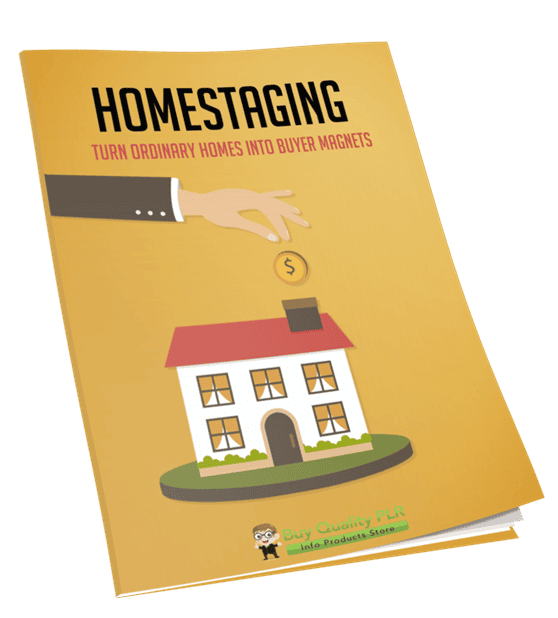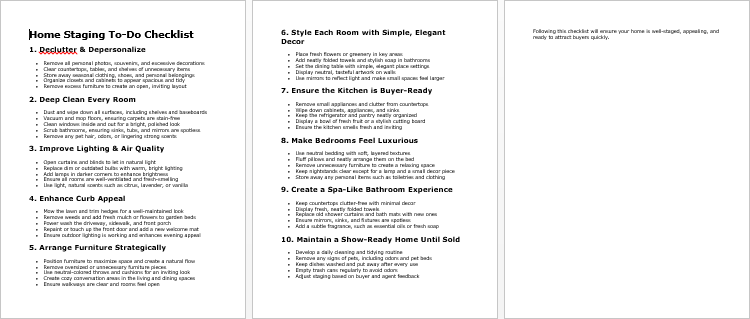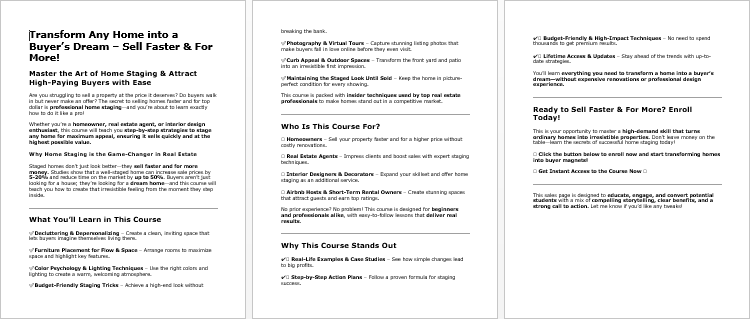
Homestaging PLR Course 20k Words
in Home Improvement PLR , Home Improvement PLR Ebooks , PLR Checklists , PLR eBooks , PLR eCourses , PLR List Building Reports , Premium PLR , Premium PLR eBooks , Premium PLR Reports , Premium White Label Brandable PLR Coaching Courses , Private Label Rights Products , Real Estate , Real Estate PLR , Real Estate PLR eBooksChoose Your Desired Option(s)
has been added to your cart!
have been added to your cart!
#homestaging #plrcourse #homestagingtips #propertyselling #realestatemarketing #homeimprovement #sellyourhome #plrcontent #realestatesuccess
Turn Ordinary Homes Into Buyer Magnets – With Your Own PLR Product
Are you looking for a high-quality, ready-to-use PLR product that appeals to a wide audience? The Homestaging PLR Course is your ultimate solution. With this complete package, you can offer aspiring home stagers, homeowners, and interior design enthusiasts a proven system to transform any home into a buyer’s dream.
Home staging is a booming industry. Sellers want to sell faster and at higher prices, and professional stagers are in demand. By leveraging this PLR course, you can tap into a lucrative market without creating content from scratch.
Whether you want to resell the course as a digital product, create smaller reports, build an e-class, or add it to a membership site, this PLR package gives you endless possibilities to generate revenue.
Presenting…
Homestaging PLR Course 20k Words
What Makes This Homestaging PLR Course So Valuable
This course is fully editable, brandable, and monetizable, providing everything you need to sell it as your own product. Here’s what makes it stand out:
- Comprehensive Content: 18,470 words covering every aspect of home staging.
- Step-by-Step Guidance: Learn to declutter, depersonalize, style, and enhance both interiors and exteriors.
- Ready-to-Use Materials: Includes checklists, FAQs, and even a sales page template to help you start selling immediately.
- Flexible Monetization: Sell as a complete course, break into reports, bundle, or convert into audio/video content.
With this package, you don’t just get a course – you get a complete business-ready solution that allows you to profit from a growing market in real estate, interior design, and digital products.
Inside the Homestaging PLR Course
This course is divided into five main modules plus bonus resources, making it easy for anyone to follow and apply the techniques:
Module 1: Understanding the Basics of Home Staging
- Learn what home staging is and why it dramatically impacts property sales.
- Understand buyer psychology: what makes a home appealing and memorable.
- Discover the key principles of effective staging, including simplicity, cleanliness, balance, and lighting.
- Build your essential home staging toolkit, using budget-friendly strategies that produce professional results.
Module 2: Decluttering & Depersonalizing for Maximum Impact
- Master the “3-Box Method”: Keep, Donate, Toss – to create spacious, welcoming areas.
- Depersonalize without leaving a cold or empty space, appealing to a wide audience.
- Optimize storage spaces like closets and cabinets, as buyers often inspect them closely.
- Implement deep cleaning techniques that make the home fresh, sparkling, and buyer-ready.
Module 3: Room-by-Room Staging Strategies
- Living Room: Open up space, arrange furniture for conversation, and add cozy touches like rugs, pillows, and soft lighting.
- Kitchen: Clear clutter, style countertops with subtle décor, fresh fruit, or flowers to create a homey feel.
- Bedrooms: Use neutral tones, luxurious bedding, and soft lighting to evoke calm and comfort.
- Bathrooms: Transform into spa-like spaces with cleanliness, white towels, candles, and fresh soap.
Module 4: Enhancing Curb Appeal & Outdoor Spaces
- Boost first impressions by trimming bushes, mowing lawns, and adding fresh flowers.
- Create an inviting entryway with doormats, potted plants, and clean porch areas.
- Stage patios and outdoor living spaces with cozy furniture, small dining setups, and ambient lighting.
- Organize garages and driveways, ensuring the exterior reflects the home’s value.
Module 5: The Final Touches & Selling Success
- Add finishing touches for a “wow factor”: fresh flowers, light music, and pleasant scents.
- Stage homes for professional photos and virtual tours, highlighting each space’s best features.
- Create pre-showing checklists to maintain the staged look until the home is sold.
- Implement a daily tidying routine to keep everything pristine.
Bonus Materials Included
Your purchase of this PLR course also includes valuable extras to help you sell and deliver even more value:
- Homestaging Checklist (507 words): Ensure nothing is overlooked during staging.
- Homestaging FAQs (1,071 words): Anticipate buyer questions and provide expert answers.
- Sales Page Template (585 words): A ready-made, high-converting sales page for your product.
How You Can Profit With This PLR Course
This course is designed for maximum monetization potential, allowing you to generate income in multiple ways:
- Sell the Course as-Is: Offer it to your audience as a complete, professional product.
- Break Into Smaller Reports: Divide content into niche-focused reports ($10–$20 each).
- Bundle With Other Content: Create premium packages ($47–$97) by combining with related products.
- Create a Membership Site: Use the content to generate recurring revenue monthly.
- Develop an E-Class or Workshop: Convert it into a multi-week online course ($297–$497).
- Turn Into Audio or Video Content: Reach audiences who prefer different learning formats.
- Use as Lead Magnets or Blog Content: Excerpt portions to build your email list and brand authority.
- Flip a Productized Website: Build a site around this course and sell it for a profit.
With this PLR product, the possibilities are endless – all you need is your brand, creativity, and marketing strategy.
Who Should Use This PLR Course
- Aspiring Home Stagers: Start your home staging business and offer services to sell homes faster.
- Homeowners Selling Property: Stage your home professionally and increase your selling price.
- Interior Design Enthusiasts: Expand your skills and portfolio with expert staging strategies.
- Digital Product Entrepreneurs: Rebrand and sell a ready-made, high-quality course to your audience.
PLR License – What You Can and Cannot Do
Permissions:
- Rebrand and sell as your own product.
- Edit, excerpt, or combine content to create new products.
- Use as membership content, audio, video, or lead magnets.
- Monetize freely without creating new content from scratch.
Restrictions:
- Do not pass PLR rights to your customers.
- Do not give away the full package for free.
- Affiliate commissions for this content are capped at 75%.
This ensures your product maintains value and exclusivity, while giving you full freedom to profit.
Why You Need This Course Today
The Homestaging PLR Course is more than just content – it’s a business-building asset. By investing in this PLR package, you get:
- Instant Content: No writing, research, or creation required.
- Market-Ready Materials: Ready to sell, rebrand, or repurpose.
- Expertly Written Content: Professional quality that builds trust with your audience.
- Monetization Flexibility: Multiple ways to earn – from small reports to high-ticket e-classes.
Whether your goal is selling homes, teaching staging, or creating a profitable digital product, this PLR course gives you the complete framework.
Take Action Now
The Homestaging PLR Course is your chance to tap into a growing market and start generating income immediately. With ready-made content, bonuses, and monetization options, you can start your next digital product or service with confidence.
Don’t wait – transform homes, attract buyers, and build your business today!
Grab Your Homestaging PLR Course Now and Start Profiting!
has been added to your cart!
have been added to your cart!
Here A Sample of Homestaging PLR Course
Welcome to Homestaging, where you’ll learn how to transform any property into a buyer’s dream home! Whether you’re staging your own home for sale, working as a professional stager, or just want to improve your decorating skills, this course will guide you through step-by-step techniques to enhance a home’s appeal.
By the end of this course, you’ll know how to declutter, rearrange, and style a home to create a welcoming space that attracts buyers and maximizes property value.
Module 1: Understanding the Basics of Home Staging
Before diving into hands-on techniques, let’s first understand why home staging is so powerful and what it can do for a property.
Step 1: What is Home Staging and Why Does it Matter?
Understanding Home Staging
Home staging is the strategic process of preparing a home for sale by enhancing its aesthetic appeal to attract potential buyers. It involves arranging furniture, decluttering, optimizing lighting, and using decorative elements to create an inviting atmosphere that allows buyers to visualize themselves living in the space.
Home staging is not just about making a home look beautiful—it is a powerful marketing tool that transforms a property into a product that appeals to the broadest audience possible. This approach can make the difference between a quick sale at a high price and a prolonged listing with multiple price reductions.
In this section, we will cover:
- The impact of home staging on the real estate market
- How staging affects buyer psychology
- Why staged homes sell faster and at higher prices
Why Home Staging is Essential in Real Estate
In competitive real estate markets, first impressions are everything. When buyers walk into a home (or even view it online), they form an opinion within the first few seconds. If the home feels warm, spacious, and well-maintained, they are more likely to develop an emotional connection and see themselves living there.
A well-staged home creates an experience that is visually appealing, emotionally engaging, and functionally optimized. Buyers do not just want to see a house—they want to feel at home.
Key Benefits of Home Staging
1. Staged Homes Sell Faster
- Studies show that staged homes sell 50%–80% faster than non-staged homes.
- Buyers make decisions quickly, and a staged home reduces the time it spends on the market.
- The longer a home stays listed, the more likely it is to receive lower offers.
2. Staged Homes Sell for Higher Prices
- According to real estate reports, staged homes sell for 5%–20% more than non-staged homes.
- A small investment in staging can result in a significant return on investment (ROI).
- Buyers perceive well-staged homes as move-in ready, making them willing to pay a premium price.
3. Staging Highlights the Home’s Best Features
- Every home has unique selling points, such as high ceilings, large windows, or a spacious layout.
- Home staging draws attention to these strengths while minimizing flaws.
- Proper lighting, furniture placement, and décor choices enhance the perceived value of a home.
4. Staged Homes Stand Out in Online Listings
- Over 90% of homebuyers start their search online.
- Professional staging ensures that listing photos look stunning and inviting.
- High-quality images increase click-through rates, attracting more potential buyers.
5. Home Staging Reduces Negotiations and Price Reductions
- When buyers see a home that feels well-maintained and visually appealing, they are less likely to negotiate for a lower price.
- A well-staged home creates a sense of urgency among buyers, leading to stronger offers and fewer price reductions.
The Psychology Behind Home Staging
1. Buyers Buy Emotionally, Not Just Rationally
People make purchasing decisions based on emotion first, then justify them with logic. A staged home creates positive emotional triggers, making it easier for buyers to form a connection with the space.
2. First Impressions Happen in Seconds
- Studies suggest buyers form an opinion within 7–10 seconds of entering a home.
- If the home feels clean, inviting, and well-designed, buyers are more likely to stay longer and explore.
3. The Illusion of Space and Light
- A well-staged home appears larger, brighter, and more welcoming.
- Simple tricks like proper furniture placement, neutral wall colors, and natural lighting create an illusion of more space.
4. The “Move-In Ready” Appeal
- Many buyers prefer homes that require little to no renovation.
- A staged home minimizes visible flaws, helping buyers see it as a turnkey solution rather than a project.
Why Home Staging Works Across All Markets
Home staging is effective in any real estate market—whether selling a small apartment, a luxury estate, or a vacation home. The principles remain the same:
- Declutter and Depersonalize – Buyers should see a neutral space, not the current owner’s personal style.
- Create a Lifestyle Experience – Showcase how the home can be lived in, rather than just how it looks.
- Maximize Natural Light and Space – Make every room feel open, airy, and inviting.
- Highlight the Home’s Strengths – Draw attention to architectural details and functional spaces.
Final Thoughts
Home staging is one of the most powerful tools in real estate marketing. It increases the perceived value of a property, attracts more buyers, and leads to faster sales at higher prices. Whether working as a professional home stager, a real estate agent, or a homeowner preparing to sell, understanding these staging principles can create a significant advantage in the market.
In the next step, we will explore the key principles of effective home staging and learn how to create a home that appeals to the widest range of buyers.
Understand the psychology of buyers and what they look for in a home.
Step 2: The Key Principles of Effective Staging
Home staging is an art and a science. It is about creating a space that buyers can emotionally connect with while ensuring the home looks spacious, well-maintained, and move-in ready. Effective home staging follows key principles that help achieve the perfect balance between style, comfort, and function.
This step will cover:
- The Four Core Principles of Home Staging
- Essential Dos and Don’ts of Staging
- How to Avoid Common Mistakes That Can Hurt a Sale
The Four Core Principles of Home Staging
To create a space that resonates with potential buyers, home staging should focus on:
- Cleanliness – The foundation of any well-staged home.
- Simplicity – A clutter-free space makes rooms feel larger and more appealing.
- Balance – The right furniture placement creates flow and harmony.
- Lighting – Proper lighting enhances ambiance and highlights key features.
Each of these principles plays a critical role in maximizing the home’s appeal and value. Let’s go step by step through how to implement them effectively.
1. Cleanliness: The First and Most Important Step
Buyers associate cleanliness with good maintenance. A spotless home makes a powerful first impression, showing that the property has been well cared for and is move-in ready.
How to Ensure a Home is Staged to Perfection
- Deep Clean Everything – Floors, windows, walls, kitchens, and bathrooms should be spotless. Pay extra attention to grout lines, stainless steel appliances, and mirrors.
- Eliminate Odors – Buyers are sensitive to smells. Remove pet odors, cooking smells, and mustiness by using natural air purifiers, essential oils, and proper ventilation.
- Keep Windows and Mirrors Streak-Free – Clean glass surfaces to maximize natural light and create an airy feel.
- Ensure a Fresh and Neutral Scent – A clean scent (like fresh linen or light citrus) enhances the home’s ambiance. Avoid overpowering artificial fragrances, as they may cause discomfort.
Common Cleaning Mistakes to Avoid
❌ Skipping hidden areas (buyers check inside closets, under sinks, and behind furniture).
❌ Using overpowering cleaning products that leave strong chemical smells.
❌ Leaving stains on carpets, countertops, or walls.
2. Simplicity: Less is More
A staged home should feel welcoming, open, and uncluttered. Buyers should be able to mentally place their own belongings in the space rather than being distracted by excessive decor or personal items.
How to Achieve a Simple, Elegant Staging Style
- Declutter Every Room – Remove excess furniture, personal photos, and decorative items that make the space feel crowded.
- Use a Neutral Color Palette – Soft whites, light grays, and beige tones make a home feel calm, spacious, and universally appealing.
- Limit Decorative Items – Keep accessories minimal: a few tasteful vases, coffee table books, or candles can create a sophisticated look.
- Keep Countertops Clear – In the kitchen and bathrooms, remove unnecessary items to highlight counter space and storage potential.
Common Simplicity Mistakes to Avoid
❌ Over-decorating (too many accessories, pillows, or wall art can feel overwhelming).
❌ Leaving too many personal items (family photos, religious symbols, or niche decor may alienate buyers).
❌ Keeping mismatched or oversized furniture that makes rooms feel smaller.
3. Balance: The Art of Furniture Placement and Room Flow
Proper furniture arrangement creates balance, movement, and functionality within a space. Buyers should be able to move freely through the home without feeling cramped.
How to Create a Well-Balanced Room
- Define Each Space Clearly – Buyers should immediately understand the purpose of every room (e.g., a reading nook, home office, or dining area).
- Ensure Symmetry Where Possible – Matching end tables, evenly spaced chairs, and balanced artwork create a visually pleasing layout.
- Avoid Overcrowding the Space – Use appropriately sized furniture. If a room is small, choose slim, space-saving pieces rather than bulky furniture.
- Create Natural Walkways – Buyers should be able to move comfortably between furniture pieces without obstructions.
Common Balance Mistakes to Avoid
❌ Pushing all furniture against the walls (floating furniture creates better flow).
❌ Having oversized furniture that makes the room feel smaller.
❌ Ignoring the scale of the room (proportion is key to a well-balanced space).
4. Lighting: The Key to a Bright and Inviting Space
Lighting dramatically affects the perception of space, mood, and warmth. A bright, well-lit home feels larger, cleaner, and more inviting.
How to Maximize Lighting in a Home
- Use Natural Light to Your Advantage – Open all curtains and blinds to let in as much daylight as possible.
- Layer Different Light Sources – Combine overhead lighting, table lamps, and accent lights to create a cozy atmosphere.
- Use Warm, White Light Bulbs – Avoid harsh fluorescent lighting; soft, warm tones create a welcoming feel.
- Highlight Key Features – Use spotlights to draw attention to architectural details, fireplaces, or artwork.
Common Lighting Mistakes to Avoid
❌ Relying only on overhead lighting (rooms need multiple light sources for depth and ambiance).
❌ Using mismatched lightbulbs (inconsistent lighting can make a home feel disjointed).
❌ Keeping dark or heavy curtains closed, blocking natural light.
Home Staging Dos and Don’ts
✅ Staging Dos
✔ Do keep it neutral and universally appealing – The goal is to attract the widest range of buyers.
✔ Do use high-quality, minimal decor – A few well-placed accessories enhance the look without overwhelming.
✔ Do consider the target buyer – A family home may need a welcoming play area, while a luxury condo should emphasize elegance.
✔ Do make small updates – Repainting, replacing hardware, and upgrading light fixtures can make a huge difference.
❌ Staging Don’ts
❌ Don’t over-furnish – A staged home should feel comfortable, not crowded.
❌ Don’t ignore curb appeal – The exterior is the first impression, so landscaping and a clean entryway matter.
❌ Don’t leave any room empty – Empty rooms make it hard for buyers to visualize their function.
❌ Don’t over-personalize – Avoid bold colors, extreme decor themes, or too many family portraits.
Final Thoughts
Effective home staging follows simple but powerful principles—cleanliness, simplicity, balance, and lighting. By mastering these elements, you can create a space that feels warm, inviting, and irresistible to buyers.
In the next step, we will explore Room-by-Room Staging Strategies to ensure every part of the home looks its best.
Step 3: The Buyer’s Perspective
When staging a home, it’s essential to shift your mindset from that of a homeowner to that of a potential buyer. Buyers walk into a home with fresh eyes, high expectations, and emotional responses. What may feel normal or unnoticeable to a homeowner—such as a dimly lit hallway, a faint pet odor, or an outdated light fixture—can be a major turn-off to a buyer.
To stage a home effectively, you must walk through the home as if you were the buyer. This exercise helps you:
- Identify strengths that should be highlighted
- Spot weaknesses that need improvement
- Create a home that feels welcoming, spacious, and move-in ready
In this step, we will cover:
- How Buyers See a Home: The Psychology of First Impressions
- Conducting a Buyer’s Walkthrough: Step-by-Step Guide
- Identifying Problem Areas and Solutions
- Final Touches: How to Make a Home Irresistible to Buyers
1. How Buyers See a Home: The Psychology of First Impressions
Most buyers form their first impression within seconds of stepping into a home. Their judgment is based on a mix of emotions, expectations, and subconscious cues.
What Buyers Notice Instantly
- Curb Appeal – A home’s exterior sets the tone. A well-maintained yard and inviting entryway create a positive first impression.
- Smell – A fresh, neutral scent is key. Unpleasant odors (pets, food, dampness) create an instant negative impression.
- Lighting – Bright, airy spaces feel bigger and more inviting. Dark or poorly lit rooms feel unwelcoming.
- Clutter & Cleanliness – A cluttered space feels chaotic, while a spotless home signals that it has been well cared for.
Why Emotional Connection Matters
Buyers want to see themselves living in the home. If a space feels warm, inviting, and move-in ready, they will feel more attached to it. If they see problems, clutter, or outdated decor, they will feel hesitant.
To stage a home effectively, you must think like a buyer and anticipate their emotional reactions.
2. Conducting a Buyer’s Walkthrough: Step-by-Step Guide
Now, let’s walk through the home as if you were a potential buyer. Take notes on what stands out—both good and bad.
Step 1: Start from the Outside (Curb Appeal Check)
Before a buyer even steps inside, the home’s exterior influences their decision.
- Does the home’s exterior look fresh and inviting? – If not, repaint the front door, clean the porch, or add potted plants.
- Is the lawn well-maintained? – Trim bushes, remove weeds, and add fresh mulch for an instant facelift.
- Are the entryway and house numbers clean and visible? – Ensure the first few seconds of arrival create a great impression.
Step 2: Enter the Home and Observe the Entryway
The entryway is the buyer’s first experience inside the home.
- Does it feel bright and welcoming? – If it’s dark, add a mirror, better lighting, or a fresh coat of neutral paint.
- Is there too much furniture? – The space should feel open and clutter-free.
- Does it smell fresh? – Eliminate pet odors or musty smells with deep cleaning and ventilation.
Step 3: Walk Through Each Room with a Critical Eye
Move through the home as if you were seeing it for the first time. Ask yourself:
✔ Is the furniture arranged to make the room feel open and spacious?
✔ Do the walls need a fresh coat of paint? (Neutral tones work best.)
✔ Are personal items (family photos, personal collections) minimized?
✔ Is there a focal point in each room? (A fireplace, large window, or well-placed artwork can draw attention.)
Step 4: Examine Kitchens and Bathrooms Closely
Buyers pay extra attention to kitchens and bathrooms because they are expensive to renovate.
- Are the countertops clear and clutter-free? – Remove small appliances, papers, and excess decor.
- Are cabinets and drawers clean inside and out? – Buyers will open them!
- Are fixtures modern and working? – Replacing outdated faucets or cabinet handles can make a big impact.
- Is the bathroom sparkling clean? – Fresh towels, a clean mirror, and a neatly arranged vanity make a difference.
Step 5: Test the Lighting and Atmosphere
- Open curtains and blinds to let in natural light.
- Turn on all lights to ensure rooms look bright and warm.
- Check for dark corners that may need additional lamps.
3. Identifying Problem Areas and Solutions
As you walk through the home, take notes on problem areas that could turn buyers away. Here are common issues and how to fix them:
| Problem Area | How Buyers Perceive It | Solution |
| Dark, dimly lit rooms | Feels small and uninviting | Add lamps, use brighter bulbs, open blinds |
| Too much furniture | Makes the space feel cramped | Remove excess furniture to improve flow |
| Cluttered shelves & surfaces | Feels messy and personal | Declutter, keep decor minimal |
| Outdated fixtures | Looks old and less valuable | Replace with modern, budget-friendly options |
| Pet odors | Can be an instant deal-breaker | Deep clean carpets, use air purifiers |
| Worn or stained carpets | Feels dirty and outdated | Professionally clean or replace carpets |
| Loud paint colors | Makes the home feel personal | Repaint with neutral, modern tones |
4. Final Touches: How to Make a Home Irresistible to Buyers
Once problem areas are addressed, small finishing touches can make the home even more appealing.
Quick Improvements for Maximum Impact
✔ Fresh flowers or plants – Add warmth and a natural feel.
✔ Soft background music – Creates a relaxing atmosphere during showings.
✔ Light, natural scent – Use subtle fragrances like citrus or lavender.
✔ Fluffy towels and decorative pillows – Small details add a luxury feel.
✔ Minimal but stylish decor – A simple vase, coffee table book, or elegant artwork makes a difference.
Final Thoughts
By walking through the home as if you were a buyer, you gain valuable insight into what needs improvement. A staged home should feel spacious, fresh, and move-in ready—not like someone else’s personal space.
In the next step, we will explore Room-by-Room Staging Techniques to perfect every area of the home.
Step 4: Essential Home Staging Tools & Supplies
Effective home staging doesn’t require a huge budget, but it does require the right tools and supplies. A well-prepared home stager can transform a space quickly and efficiently, making a home feel more inviting and appealing to potential buyers.
In this step, you’ll learn how to:
- Build a Home Staging Toolkit with Must-Have Items
- Use Budget-Friendly Staging Techniques for Maximum Impact
- Incorporate Neutral Décor and Lighting Fixes to Enhance Every Space
- Keep a Home Staging Checklist for a Smooth and Efficient Process
1. Build a Home Staging Toolkit with Must-Have Items
Every home stager should have a basic toolkit to handle quick fixes, minor upgrades, and last-minute adjustments before a showing.
Essential Home Staging Supplies
✔ Cleaning & Maintenance Supplies:
A clean home is the foundation of effective staging. Buyers notice dirt, dust, and clutter immediately, which can leave a negative impression. Stock your toolkit with:
- Multi-surface cleaners – For countertops, floors, and furniture
- Glass cleaner – For windows, mirrors, and glass tables
- Disinfectant wipes – For quick touch-ups before a showing
- Magic erasers – To remove scuffs, stains, and marks on walls
- Spackle & putty knife – To fill small holes and cracks
- Paint & brushes – For quick touch-ups on walls and trims
✔ Neutral Home Décor Essentials:
Staging requires neutral, stylish decor that appeals to a broad audience. Some key items include:
- Throw pillows in neutral tones – Adds warmth and texture
- Lightweight curtains – Enhances natural light and brightens spaces
- Stylish vases with fresh or artificial flowers – Adds a fresh, inviting touch
- Simple artwork or mirrors – Creates focal points without overwhelming a space
- Area rugs in soft, neutral colors – Defines spaces and adds coziness
✔ Lighting & Ambiance Fixes:
Lighting plays a crucial role in making a home feel open, warm, and welcoming. Your toolkit should include:
- LED light bulbs – For brighter, more energy-efficient lighting
- Floor and table lamps – To illuminate dark corners
- Soft white bulbs – To create a warm and inviting atmosphere
- Extension cords and power strips – To place lighting strategically
✔ Furniture and Space Optimizers:
Simple adjustments can make a home feel bigger and more functional. Essential tools include:
- Furniture sliders – To rearrange heavy furniture easily
- Foldable storage bins – To declutter quickly
- Closet organizers – To make storage spaces feel larger
- Bed linens in crisp white or neutral tones – Creates a fresh, luxurious look in bedrooms
2. Use Budget-Friendly Staging Techniques for Maximum Impact
Staging doesn’t have to be expensive. Small, strategic changes can dramatically improve a home’s appeal without a big budget.
Low-Cost Home Staging Tips
✔ Declutter First:
Before making any purchases, remove unnecessary items to create a clean, open space.
- Clear out personal belongings, excessive furniture, and knick-knacks
- Store items in bins or off-site to make rooms feel spacious and organized
✔ Rearrange Existing Furniture:
Instead of buying new pieces, rearrange what’s already there to optimize flow.
- Position sofas and chairs to create an open and conversational layout
- Remove bulky furniture that makes a space feel cramped or crowded
✔ Use Paint for an Instant Upgrade:
A fresh coat of neutral paint is one of the cheapest, highest-impact changes you can make.
- Stick to soft whites, beiges, and light grays for a modern, airy feel
- Paint over bold or outdated colors to appeal to a wider audience
✔ Upgrade Fixtures Instead of Replacing Them:
Instead of spending money on brand-new kitchen and bathroom fixtures, make small updates:
- Swap out cabinet handles and faucets for sleek, modern styles
- Replace outdated light switch covers and doorknobs for a fresh look
✔ Maximize Natural Light:
Natural light makes any home feel larger and more inviting.
- Remove heavy curtains and replace them with sheer or light-colored drapes
- Place mirrors opposite windows to reflect more light into a room
✔ Create a Cozy & Inviting Atmosphere:
- Use plush throw blankets and pillows to soften living areas
- Set up a small coffee station or fresh fruit bowl in the kitchen for a welcoming touch
- Light mildly scented candles (avoid strong artificial fragrances)
3. Incorporate Neutral Décor and Lighting Fixes to Enhance Every Space
Choosing the Right Décor for Staging
The goal of staging is to create a broadly appealing, neutral space that allows buyers to imagine themselves living there.
- Stick to a neutral color palette – Whites, beiges, and grays create a clean, modern feel
- Use greenery or flowers for warmth – A small vase with fresh flowers makes a big impact
- Avoid overly personal décor – Remove family photos, religious symbols, and bold artwork
Lighting Adjustments for Each Room
✔ Living Room:
- Use multiple light sources (floor lamps, table lamps, overhead lighting)
- Keep curtains open during the day to let in natural light
✔ Kitchen:
- Replace fluorescent lighting with warm LED bulbs
- Add under-cabinet lighting for a modern, high-end touch
✔ Bedrooms:
- Use soft, warm lighting for a relaxing atmosphere
- Place matching bedside lamps for balance and symmetry
✔ Bathrooms:
- Ensure the space is bright and fresh
- Use vanity lighting that mimics natural daylight
4. Keep a Home Staging Checklist for a Smooth and Efficient Process
Pre-Staging Checklist (Before You Begin)
✔ Declutter and remove personal items
✔ Deep clean all rooms, including baseboards and windows
✔ Check for unpleasant odors and use neutral air fresheners
✔ Ensure all light bulbs work and match in color
Final Staging Checklist (Before a Showing)
✔ Fluff pillows and arrange throw blankets neatly
✔ Open curtains and turn on all lights
✔ Set out neutral decorative elements (fresh flowers, simple artwork)
✔ Do a final walkthrough to ensure everything looks polished
Final Thoughts
With the right tools, supplies, and staging strategies, you can transform any home into a buyer’s dream without overspending. Simple changes, neutral décor, and strategic lighting can significantly enhance a home’s appeal.
In the next step, we will dive into Room-by-Room Staging Techniques, ensuring that every space—from the kitchen to the bedrooms—is optimized for a quick and profitable sale.
We’re also giving these extra bonuses
Homestaging – Checklist

Homestaging – FAQs

Homestaging – Salespage Content

Package Details:
Word Count: 18 470 Words
Number of Pages: 88
Homestaging – Bonus Content
Checklist
Word Count: 507 words
FAQs
Word Count: 1071 words
Salespage Content
Word Count: 585 words
Total Word Count: 20 633 Words
Your PLR License Terms
PERMISSIONS: What Can You Do With These Materials?
Sell the content basically as it is (with some minor tweaks to make it “yours”).
If you are going to claim copyright to anything created with this content, then you must substantially change at 75% of the content to distinguish yourself from other licensees.
Break up the content into small portions to sell as individual reports for $10-$20 each.
Bundle the content with other existing content to create larger products for $47-$97 each.
Setup your own membership site with the content and generate monthly residual payments!
Take the content and convert it into a multiple-week “eclass” that you charge $297-$497 to access!
Use the content to create a “physical” product that you sell for premium prices!
Convert it to audios, videos, membership site content and more.
Excerpt and / or edit portions of the content to give away for free as blog posts, reports, etc. to use as lead magnets, incentives and more!
Create your own original product from it, set it up at a site and “flip” the site for megabucks!
RESTRICTIONS: What Can’t You Do With These Materials?
To protect the value of these products, you may not pass on the rights to your customers. This means that your customers may not have PLR rights or reprint / resell rights passed on to them.
You may not pass on any kind of licensing (PLR, reprint / resell, etc.) to ANY offer created from ANY PORTION OF this content that would allow additional people to sell or give away any portion of the content contained in this package.
You may not offer 100% commission to affiliates selling your version / copy of this product. The maximum affiliate commission you may pay out for offers created that include parts of this content is 75%.
You are not permitted to give the complete materials away in their current state for free – they must be sold. They must be excerpted and / or edited to be given away, unless otherwise noted. Example: You ARE permitted to excerpt portions of content for blog posts, lead magnets, etc.
You may not add this content to any part of an existing customer order that would not require them to make an additional purchase. (IE You cannot add it to a package, membership site, etc. that customers have ALREADY paid for.)
Share Now!












